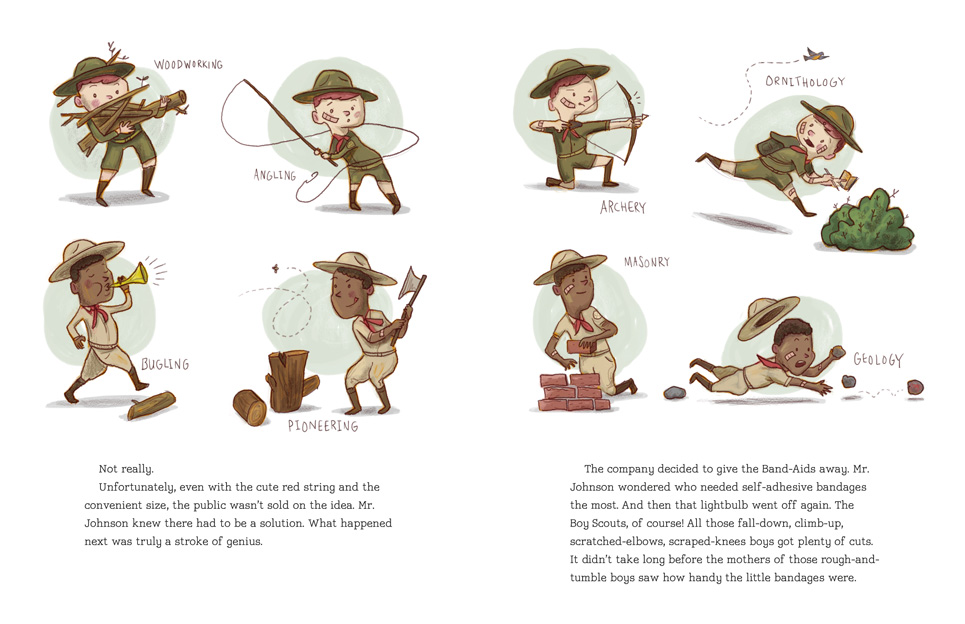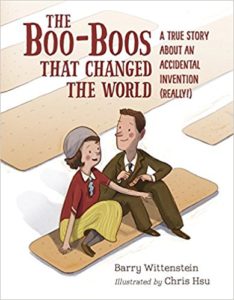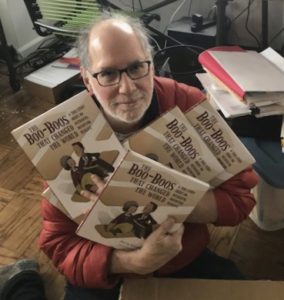The Children’s Book Review | March 15, 2018
Which five words best describe The Boo-Boos That Changed the World: A True Story About an Accidental Invention (Really!)?
Barry Wittenstein: Funny, really funny, clever, a bloody love story, educational, entertaining, surprising, fascinating, best seller, award winner, The End (not really).
Is that five?
Can you share one highlight from The Boo-Boos That Changed the World with our readers?
One highlight is the fact that until Johnson & Johnson gave the Band-Aids away to the Boy Scouts, the product didn’t catch on. Who knew?

What has been the best reaction from a reader, so far?
One teacher wrote that Boo-Boos will create a “dynamic feel to story time.” I love that comment. She meant that the running gag of THE END after every few pages really creates a start and stop, call and response interaction.
Why do you think non-fiction books are an important part of a child’s home library?
Obviously, learning about historical figures and events is crucial to being a well-rounded individual. A low-information citizenry is a prescription for chaos. By reading nonfiction, you improve your chances of not repeating the horrors and missteps of the past. Every generation thinks they invented the wheel. History teaches unbelievable interesting lessons and introduces fascinating events and personalities to the reader. Getting kids hooked on nonfiction will keep them hooked throughout their lives. To quote from one of my favorite movies of all time, Animal House, “Knowledge is good.”
As with any subject, if the information is not presented in an accessible or entertaining manner, the audience won’t be engaged. By which I mean, it can’t be fact followed by fact. That’s a textbook. That’s where good storytelling comes in. Creative nonfiction and historical fiction. Using the literary tools of fiction to bring nonfiction to life. It wasn’t always this way. But writers like Gay Talese and Thomas Wolfe, among others, in the mid 1960s pushed the boundaries. There is a direct connection between their writing and the style and popularity of today’s nonfiction picture books.
Can you tell us about a boo-boo of your own?
Well, I’ll tell you about my most recent boo-boo. Last summer, I clunked my head on a car door and gave myself a mild concussion. For a month I had headaches. It really gave me fog brain. My wife would ask me a question, and I’d hear it, but it took a few seconds to think of the answer and for the words to come out. I wasn’t worried about not recovering. But it definitely was a sort of an out-of-body experience. Like me watching me trying to talk. Weird. Unfortunately, it happened a few days before I was to fly from NY to LA for the SCBWI Conference. Couldn’t go.
For your writing energy: sugar or salt, tea or coffee?
My writing energy? Coffee. Usually iced. Usually at a Starbucks. If I write at home, I will write a little, then truck off to the fridge, go back to writing, write a little more, truck back to the fridge again. And the combination of stuff I eat is gross. Makes no dietary sense. Unconscious. Which is why I go to Starbucks and order coffee. Usually iced.
Writing tools: computer, pen and paper, or all of the above?
My writing tools are many, and the process usually in this order: write using Microsoft Word on an iPad, print out what I’ve done, edit with a pen, incorporate changes back into Word. There are some incredible software programs like Save the Cat!, Scrivener, and Contour, which assist in organizing plots, tension, character development, etc. Occasionally I’ll utilize those. Also an online thesaurus and dictionary are crucial to have around.
What’s on your nightstand? Any books?
I like to keep a variety of genres nearby. Some old, some new. At the moment, I’m reading Tonya Bolden’s picture book, Beautiful Moon: A Child’s Prayer, Andrea Davis Pinkney’s Martin Rising: Requiem for King, and Monster by Walter Dean Myers. But next week it could be specifically related to a subject I’m thinking of writing about. Which means, adult nonfiction, historical in nature. Always changing.
In addition to books, I am always looking at Twitter, checking out the comments and links to political writers of the day. It will be interesting to read the nonfiction picture books five or ten years down the road about this era.
Can you tell us something that even your most loyal fans may not know about you?
I have to laugh. My most loyal fans? I’m shocked! Shocked! I have fans? Nobody knows anything about me. Like most people, I have a whole bunch of crazy stories from my life. Chance meetings with celebrities, things like that. Also, I’ve lived a kind of Walter Mitty life. Done a zillion jobs. Bartender, NYC taxi driver, NYC substitute teacher, worked with a photojournalist doing audio recordings, writer and web editor for Major League Baseball, recorded songwriter.
One anecdote that I haven’t thought of for a while. When I was a bit younger, I often got mistaken for Steven Spielberg, especially if I was wearing a baseball cap. One time, a little old Jewish lady saw me, did a double take, then patted me on the arm and said, “Thank you.” This was around the time Spielberg was doing the Shoah project, recording the stories from Holocaust survivors. I didn’t want to tell her she was mistaken, that it was just me. So I said, “You’re welcome.” I probably made her day. Though later, I did wonder if I should have come clean.
Is there anything else you would like to share with our readers?
I love pizza, and chocolate cake. Sometimes I’ll eat the pizza first, other times, the cake. I’m trying to teach my two dogs how to speak. I don’t mean bark. I mean, speak English. It’s been tough going. I used to wear Levis 559s, now it’s 511s. I love Coen Brothers movies. That’s about it. Pretty boring.
—
 The Boo-Boos That Changed The World: A True Story About An Accidental Invention (Really!)
The Boo-Boos That Changed The World: A True Story About An Accidental Invention (Really!)
Written by Barry Wittenstein
Illustrated by Christ Hsu
Publisher’s Synopsis: Did you know Band-Aids were invented by accident?! And that they weren’t mass-produced until the Boy Scouts gave their seal of approval?
1920s cotton buyer Earle Dickson worked for Johnson & Johnson and had a klutzy wife who often cut herself. The son of a doctor, Earle set out to create an easier way for her to bandage her injuries. Band-Aids were born, but Earle’s bosses at the pharmaceutical giant weren’t convinced, and it wasn’t until the Boy Scouts of America tested Earle’s prototype that this ubiquitous household staple was made available to the public. Soon Band-Aids were selling like hotcakes, and the rest is boo-boo history.
Ages 4-8 | Publisher: Charlesbridge | February 13, 2018 | ISBN-13: 978-1580897457
Available Here:



Praise:
★”Appealingly designed and illustrated, an engaging, fun story about the inspiration and inventor of that essential staple of home first aid.” —Kirkus Reviews (starred review)
“A funny and illuminating nonfiction entry that will hold particular appeal for aspiring inventors and future medical professionals.”—School Library Journal
About the Author

Barry Wittenstein has always been involved with writing, from contributing to his high school and college newspapers, to writing and performing poetry on stage in San Francisco, songwriting, sports writing, and now picture books.
He has worked at CBS Records, CBS News, and was a web editor and writer for Major League Baseball. He is now an elementary-school substitute teacher and children’s author.
Barry particularly likes nonfiction, and profiling mostly unknown people and events whose stories have never been told in children’s literature. He is the author of Waiting for Pumpsie and The Boo-Boos That Changed the World. He lives in New York City. To learn more, visit his website: https://onedogwoof.com/ or on Twitter: @bwittbooks

3 Comments
I really enjoyed reading about Barry. I totally agree that children should read non fiction early. Thanks for the opporunity to win.
Congratulations to Carl S. (AZ)! You are the winner of this “bloody love story.” A copy will be on the way to you soon Enjoy!
Thanks Bianca, I’m really looking forward to it!